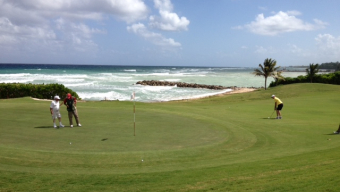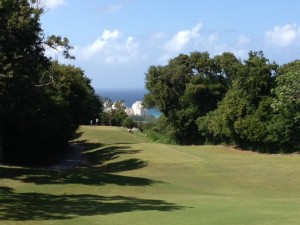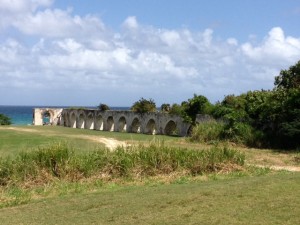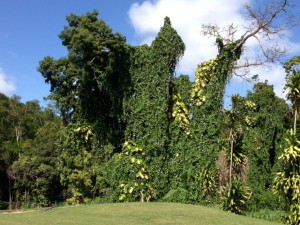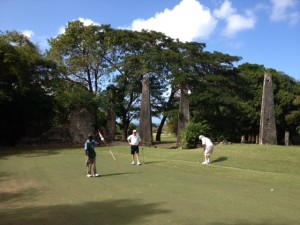MONTEGO BAY, Jamaica –When you tee the ball up at the venerable Cinnamon Hills golf course here you get more than 18 holes of island golf. You set off on a journey that passes alongside the turquoise Caribbean waters on the front nine to the virtually impenetrable jungle on the back.
Along the way you also get a bonus – a slice of Jamaican history and a vision of what the island might have looked like four centuries ago.
Cinnamon Hills is located on the northern edge of Jamaica between Falmouth and Montego Bay. It is run by the Hilton Rose Hall Resort just next door. The course, designed by Hank Smedley, was opened in 1969 and originally called Three Palms Ocean Course. It was redesigned in 2001 by Hagee and Baril.
Both sets of architects preserved the ‘relics’ on the property, such as the 17th century aqueduct that brought water to the sugar cane fields, the burial plot for the family of English poet Elizabeth Barrett Browning near the fourth tee, an ancient well along the 15th fairway and the elegant – and some say haunted – gleaming white Rose Hall Great Hall adjacent to the second hole.
Behind the 15th green, you’ll find a waterfall used as a backdrop for the James Bond movie “Live and Let Die.” Also on the property is the house that Johnny and June Carter Cash lived in for 30 years.
Come for the golf; leave with a history lesson.
Cinnamon Hills is not cheap, with green fees at $129, plus $50 club rental, the day we played this February. You drive carts and are joined by a pair of mandatory forward caddies in each foursome. The customary caddy rate is $20, plus of tip of your discretion.
It was our feeling that the caddies were inconsistent at reading putts but so worth it in providing us with the essence of the island’s ‘no worry, mon’ attitude as well as their insights into the region’s history.
The blue (back) tees play 6,828 yards and the yellow (front) tees play 5,890. We played the middle while tees at a comfortable 6,380 yards.
The first hole is straightforward, par-5, 518 yards (whites). It’s a good starter hole for guys playing a new course with rented clubs and winter swings. The green slopes toward the tee and the pin was at the bottom, tending to yield three putts for most of us to start the day.
From the second tee, you see the white Rose Hall Great Hall in the distance. It was built in 1770 by John Palmer and eventually became the residence of his grandnephew John Rose Palmer and his wife Annee. It was said that Annee possessed ‘black magic’ and did away with two husbands and various lovers. She became known as the White Witch of Rose Hall and some say they’ve seen her ghost image wandering throughout the house.
In describing the story, we thought our caddies Romario and Owen were saying “Arnie” – not Annee – Palmer so we were a bit confused why Arnold Palmer was knocking off people in Jamaica. We learned the real story later.
When we reached the par-5, 432-yard fifth hole (pictured at the top) we fully realized we were playing Caribbean golf. It’s the course’s signature hole, by far. You look straight down the fairway toward the ocean, with the green within feet of the crashing waves. It’s also mighty tough as the prevailing winds are into your face. On this day, the winds were whipping at more than 15 miles per hour, making it a terrible beauty.
The next hole also is quite impressive, a par-3, 146-yard hole called ‘witches reef.’ To the right is the rocky shore and in front of the green is a yawning trap. It’s a difficult shot to even take a shot at the pin if it is planted on the right side. And it was. And it was.
Alongside the par-4, 395-yard seventh hole are the ancient aqueducts that brought water to the sugar cane fields. Built in the 1600s, it looks like much like the Roman aqueducts, quite monumental and historic. The Spanish, who had discovered and claimed the island, used West African slaves – no doubt ancestors of our caddies – to work the fields and the sugar cane factory.
By now, if you have a decent round going, don’t get too cocky. The par-5, 500-yard ninth hole will humble you. It’s among the toughest holes on the course. It’s not just long it’s usually windy, crossing or in your face. Any bit of slice off the tee and you could end up on the Queen’s Highway just beyond the right-side fence. One member of our group just missed a little white sedan with his drive. Take your seven here and head to the back nine.
The back nine is inland, as you take a tunnel under the Queen’s Highway and head into the jungle. At various points you can look around and wonder where this course will take you because all you see is a thick canopy. It’s dramatically different than the mostly ocean-influenced front nine.
It starts with the 360-yard par-4 10th. There’s a narrow landing area for your drive and if you stray right or left you won’t find your drive on either side.
When you get to the par-4, 407-yard 14th tee, take a little local advice. Three of our four drives went into the woods on the right. What you don’t realize is that the tee complex is subtly pointed that way. You’ll need to shift around a little to make sure you can land safely in this tilted right-to-left fairway.
As you leave the tee, glance down to your left at the bottom of a hill and see a working well, with its peaked roof. This must be a lifeline for so many villagers in the area.
The 15th is a pure gem. It’s a par-3, 172-yard hole into an opening in the jungle. You hit off an elevated tee and must carry at least 160 yards to clear a gully. Behind the green to the left is the James Bond waterfall.
After you putt, take a moment here to gather in the beauty of this Jamaican paradise. To the left of the green is an amazing mass of morning glory, with its colorful blue blossoms, intertwined among the trees. To the right you see a hill overwhelmed with jungle vegetation.
One nice thing my caddy Romario did here was clip a branch off a cinnamon tree. He had me take a couple leaves and rush them in my hand. Then smell. Wonderfully aromatic. I even took a branch back to our cruise ship to let others smell the island beauty.
The course finishes with par-5s both on 17 (496 yards) and 18 (479 yards). Both are fraught with hazards. No. 17 has to be a favorite, mainly for its challenge. You hit off an elevated tee and need to steer your drive a little right at the end. Too far right and you are in the thick stuff. Too far and you are in a gully. If you can nuzzle your ball close to the gully you have a chance to reach the green with a little right-to-left swing. Not too far left or you encounter a series of bunkers.
Behind the hole, you’ll see more remnants of the ancient aqueduct.
Eighteen’s main obstacle is a trench about 40 yards wide just in front of the green. You have to lay up on your second shot then make sure you have the exact yardage on your wedge over the trench to the green.
Whether you come by ship or plane, this dandy course is worth the effort. The caddies are fun, the course is delightful and the island history is just a slice away.





